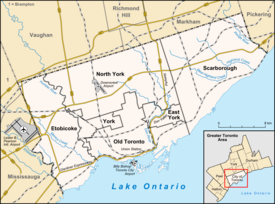Alderwood, Toronto
| Alderwood | |
|---|---|
| Neighbourhood | |

The Alderwood United Church
|
|
| Location within Toronto | |
| Coordinates: 43°36′27″N 79°32′25″W / 43.60750°N 79.54028°WCoordinates: 43°36′27″N 79°32′25″W / 43.60750°N 79.54028°W | |
| Country |
|
| Province |
|
| City |
|
| Community | Etobicoke |
| Established | 1918 (Subdivision) 'New Toronto Park' 1933 (Postal village) |
| Changed Municipality | 1998 Toronto from Etobicoke |
| Government | |
| • MP | Bernard Trottier (Etobicoke—Lakeshore) |
| • MPP | Peter Milczyn (Etobicoke—Lakeshore) |
| • Councillor | Mark Grimes (Ward 6 Etobicoke—Lakeshore) |
Alderwood is a neighbourhood in the city of Toronto, Ontario, Canada. It is in the western section of Toronto, formerly the city of Etobicoke. It is bounded by the Etobicoke Creek to the west, the Gardiner Expressway to the north, the CPR railway to the east and the CNR railway to the south.
Alderwood is named after Etobicoke, the municipality of which it originally was a part, which is a native word meaning 'place where the alder trees grow'.
With Long Branch, Alderwood was originally part of Col Sam Smith's land. In 1850, Archibald Cameron purchased four farm lots of this land comprising most of the area that is now Alderwood; he built his home 'Ashfield' on what is now Beta Street. In 1874 Archibald Cameron was facing bankruptcy and sold his farm lots to Daniel Horner, who later served as a prominent member of Etobicoke Township's Council; Horner Avenue is named after him. The naming of Alderwood's main street was a hotly debated issue in the early community between the Brown and O'Connor families; today it is called Brown's Line.
About 1920 what is now Alderwood was first planned as an extension of the newly incorporated Town of New Toronto and was originally called 'New Toronto Heights' or 'New Toronto Park ' with the first streets planned in a simple grid pattern with names from the Greek alphabet (Beta, Gamma, Delta). Alderwood was still part of the original Etobicoke township. In 1933 Alderwood became a postal village remaining in Etobicoke Township although closely connected to the independent municipalities Long Branch and New Toronto to the south, but separated by the railway. Although Alderwood did not undergo significant growth until after the Second World War, many industries moved into the area along Brown's Line during the war years. Alderwood was further disconnected from the rest of Etobicoke Township to the north by the construction of the Queen Elizabeth Way in the 1930s and the industrialisation of much of Etobicoke immediately to the north which cemented Alderwood's closer attachment to the independent municipalities of Long Branch and New Toronto to the south. After the war, increased immigration, particularly from eastern Europe, led to the rapid urbanisation of the area which continued until the end of the 1960s.
...
Wikipedia

